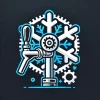Searle / Kelvion – CellarMaster Units
Searle was a British manufacturer of refrigeration heat exchangers and condensing units (now part of Kelvion). In the context of pub cellars, Searle produced components and even packaged systems often referred to as Cellar Master units. In fact, the original BeerMaster units of the 90s used Searle evaporators adapted with electronics, and Searle sold their own CellarMaster branded coolers (with model codes like CMO-150, etc.). These might not be as widely recognized by public, because they were often white-label or integrated into brewery systems, but you’ll occasionally find equipment plates saying “Searle Cellar Cooling” with a model number. The capacity range was similar (3–7 kW) targeting beer cellars. They typically used conventional controls (mechanical or basic electronic thermostat, and pressure switches).
Common Faults: Being similar in era to IMI systems, age-related issues are common. Additionally, Searle’s coils (excellent build) but any steel parts like fan guards or cases can rust. If a CellarMaster isolator (fused switch) was installed as part of it, check that – some had local isolators that can fail or be left off accidentally. Fault codes aren’t applicable (no integrated display). Look for subtle clues like a sight glass moisture indicator that is green vs yellow (some Searle condensers had built-in sight glasses). Yellow indicates moisture -> change drier to prevent future issues like TXV freeze-up.
Unique to Searle designs sometimes was the combination of filter/drier/sight glass near the evaporator and a tendency by some installers to add extra filter/driers in strange places – just be aware if you find multiple driers in line, each is a potential clog point.
Troubleshooting & Fixes: Overlap with previous brands – thoroughly inspect fans, coils, and controls. Searle evaporators might have used hot gas defrost if they were dual-purpose (like some coldroom units), but for cellars, probably off-cycle only. Ensure any hot-gas or bypass valves are not stuck open (if present) – a bypass stuck could cause continuous cooling or weird pressures. If the unit short cycles, maybe an adjustable HP control is turning it off and on (some older Searle condensers used dual pressure controls to cycle compressor or fan). Check those settings. For fixes, using Kelvion/Searle parts if available (like replacement coils or fans) is good, but generic replacements often work (motors, controls).
Because Kelvion still makes condensers and coils, you might retrofit a modern Kelvion condensing unit onto an old evaporator if needed. The evaporator (if not leaking) can last a long time – just flush and adapt expansion device for new refrigerant if doing that. Searle documentation might be accessible via Kelvion for reference data (capacity, etc.).
Manual: Look up Kelvion/Searle archive for “Cellar Cooling C**” series manual or the specific model. Not much online aside from parts and snippets, so general refrigeration manuals suffice.
Common Faults & Troubleshooting (Searle CellarMaster):
(Similar to IMI Cornelius above, to avoid redundancy, we’ll keep it concise. The table can be omitted or shortened if space is an issue since it overlaps with older systems content.)
-
High Head Pressure / HP Trips: Treat as per Marstair/Hubbard – likely dirty condenser or fan issue. Searle condensers had reliable fans; if motor is original, replace bearings or motor if it’s noisy or slow. Reset HP switches (if manual reset type). Ensure any fan cycling control (pressure switch controlling fan on/off) is set correctly or temporarily bypass it in hot weather so fan runs continuously.
-
Low Suction / LP Trips: Probably leak or restricted drier. Searle loved using liquid sight glasses – if you see bubbles or it’s empty, you have a leak or undercharge. Find leak (often at flare joints or old Schrader valves). Repair and recharge, and always change the filter-drier (Searle units from R22 era might have an old drier that’s long saturated). If capillary fed, might need solvent flush if burnout occurred, to clear sludge.
-
No Operation (Compressor not starting): Check any fused isolators or contactors that Searle might have included. Replace blown fuses. If a dual pressure control is wired to stop compressor on both HP and LP, check if LP has a manual reset too on some older ones (some had manual reset LP to force tech intervention on big leaks). Reset if present and see if it holds. Check compressor relay and start capacitor on single-phase units.
-
Unstable Control: If overshooting or short-cycling on thermostat, maybe retrofit a new control (digital stat will greatly improve stability). In older designs where evaporator fan cycled with compressor (some very old energy-saving designs did that), consider wiring fan to run continuously for better temperature uniformity and less stress.
Technical Notes: Searle being an OEM means your unit might be part of a larger system (e.g., some breweries had remote monitoring on them). Many had simple designs though. Always cross reference the model number to see if it’s just a coil or a condensing unit assembly. If it’s a condensing unit, Searle often used Tecumseh or Maneurop compressors – parts for those can still be sourced (e.g., contactors, overloads). Given Searle is now Kelvion, you can often contact Kelvion for help – they may have old drawings or equivalency charts. They likely won’t support control issues (since those were generic), but for coil and capacity info they might.
(Sources: Industry knowledge, Searle spare part listings, context from BeerMaster info.)

